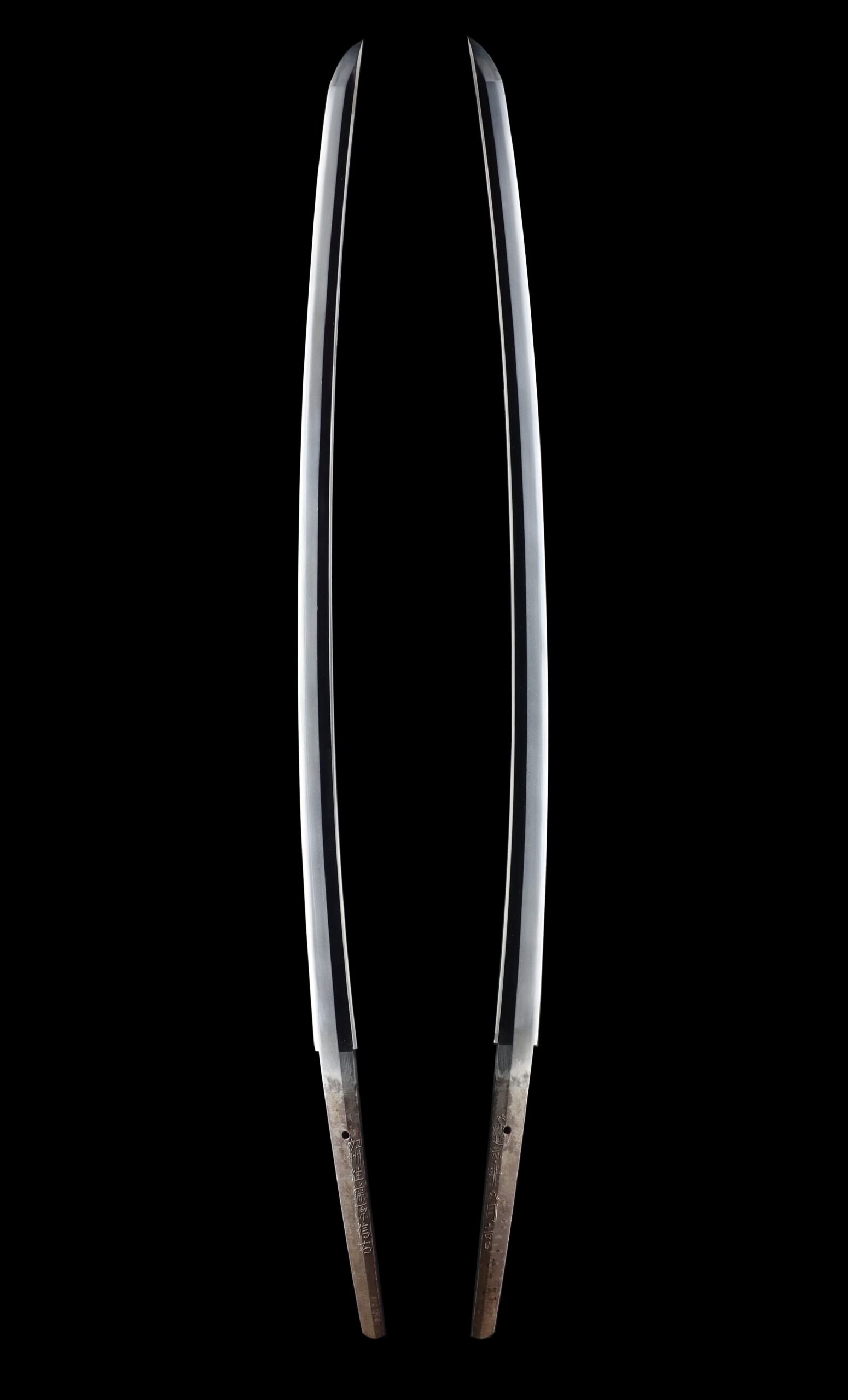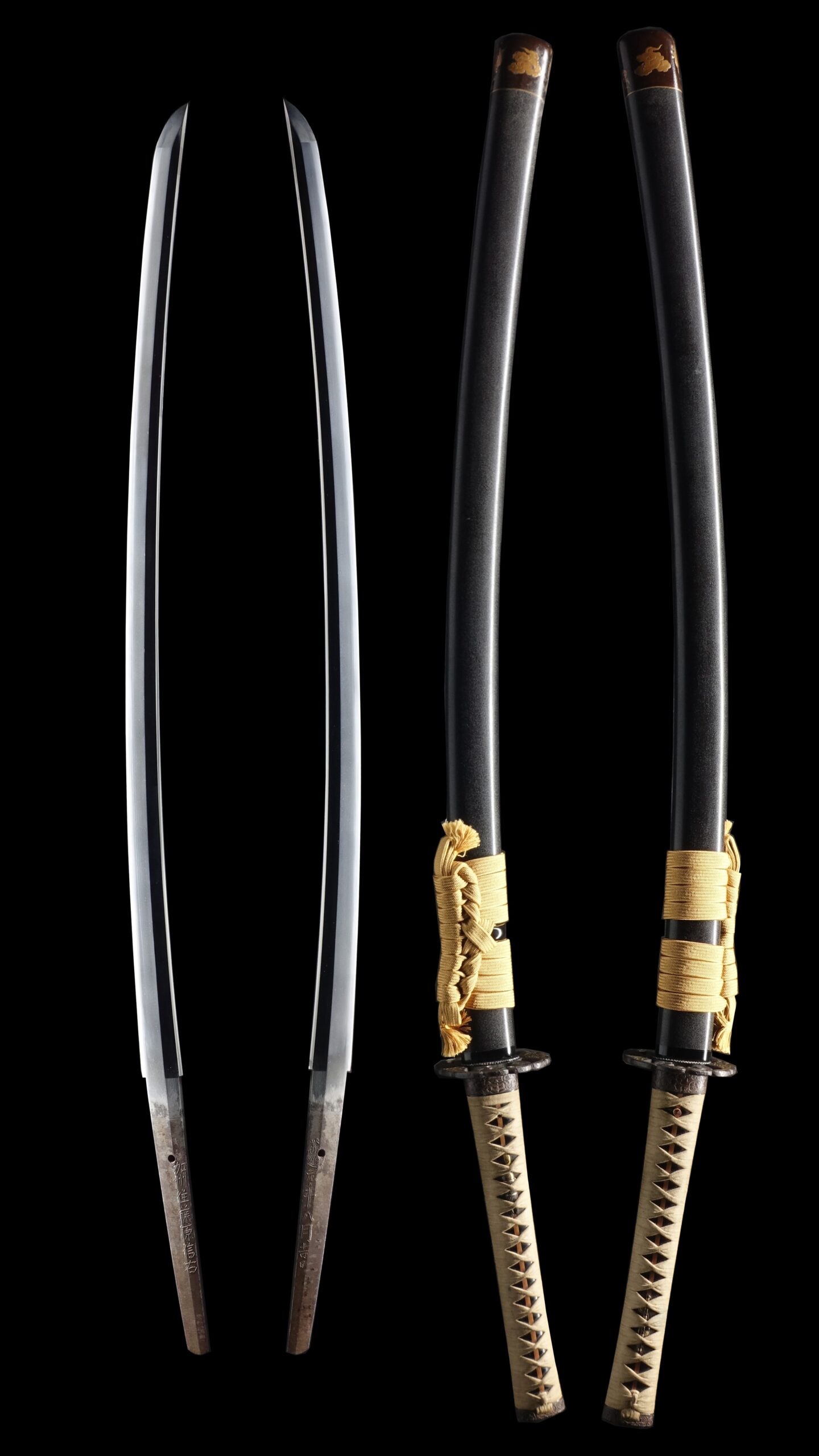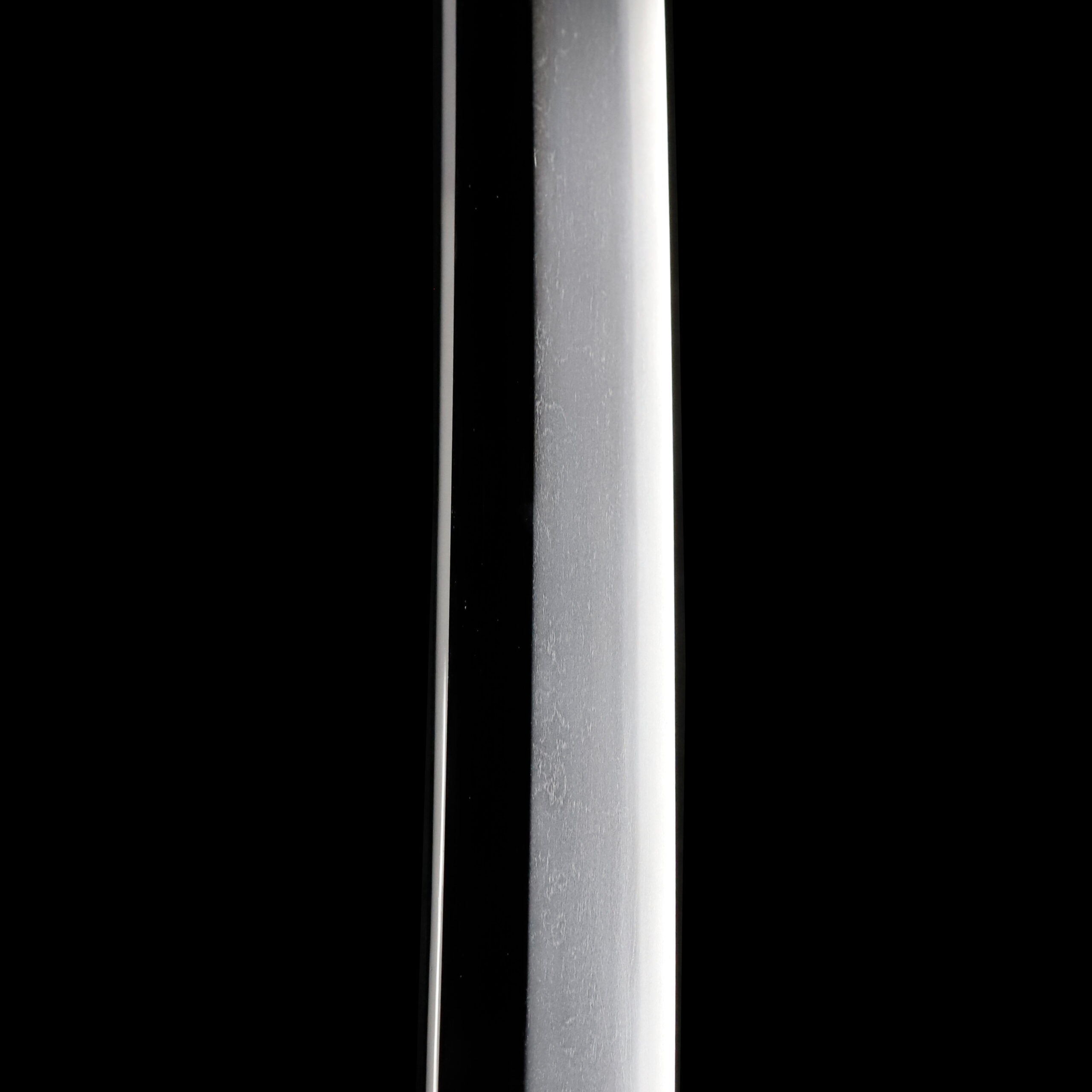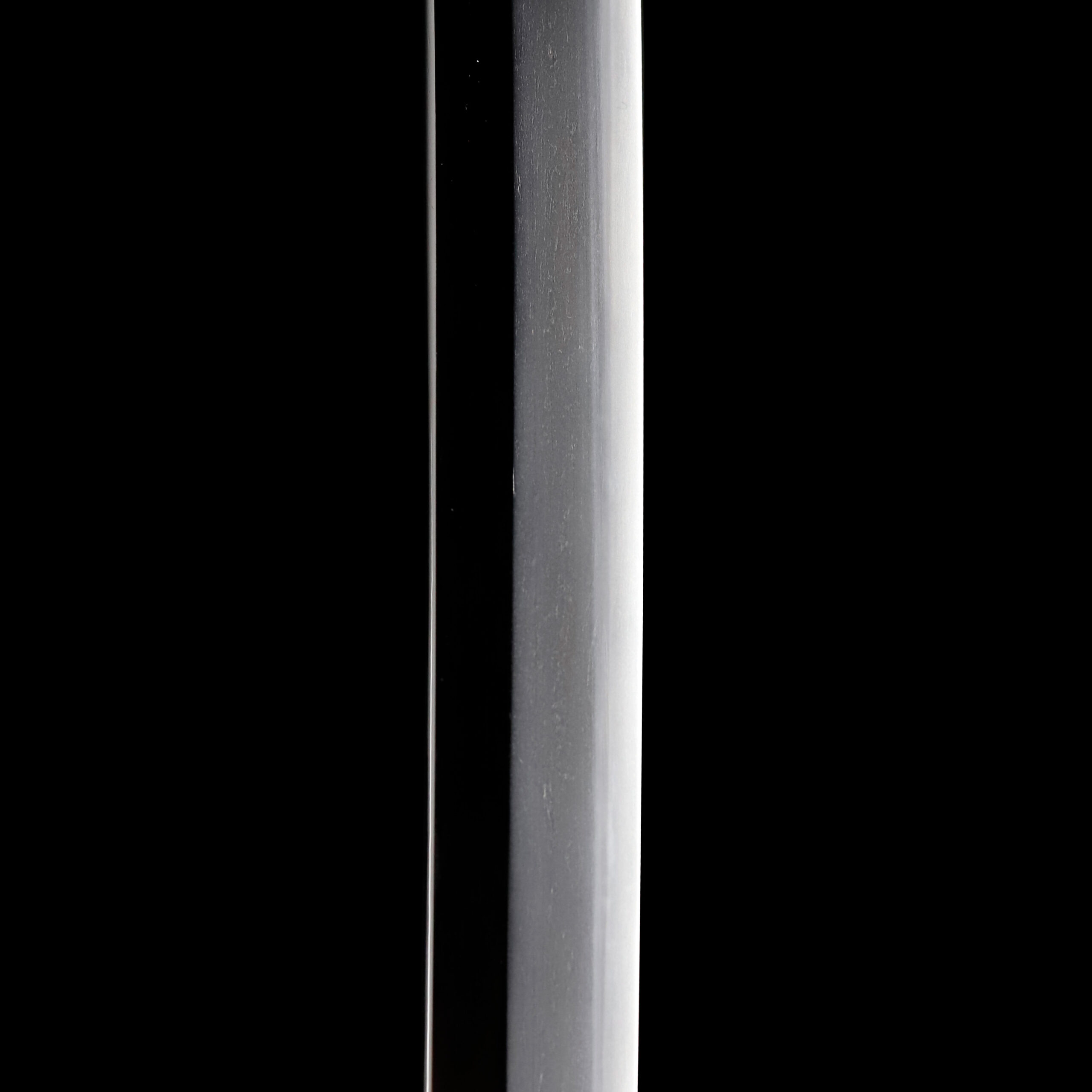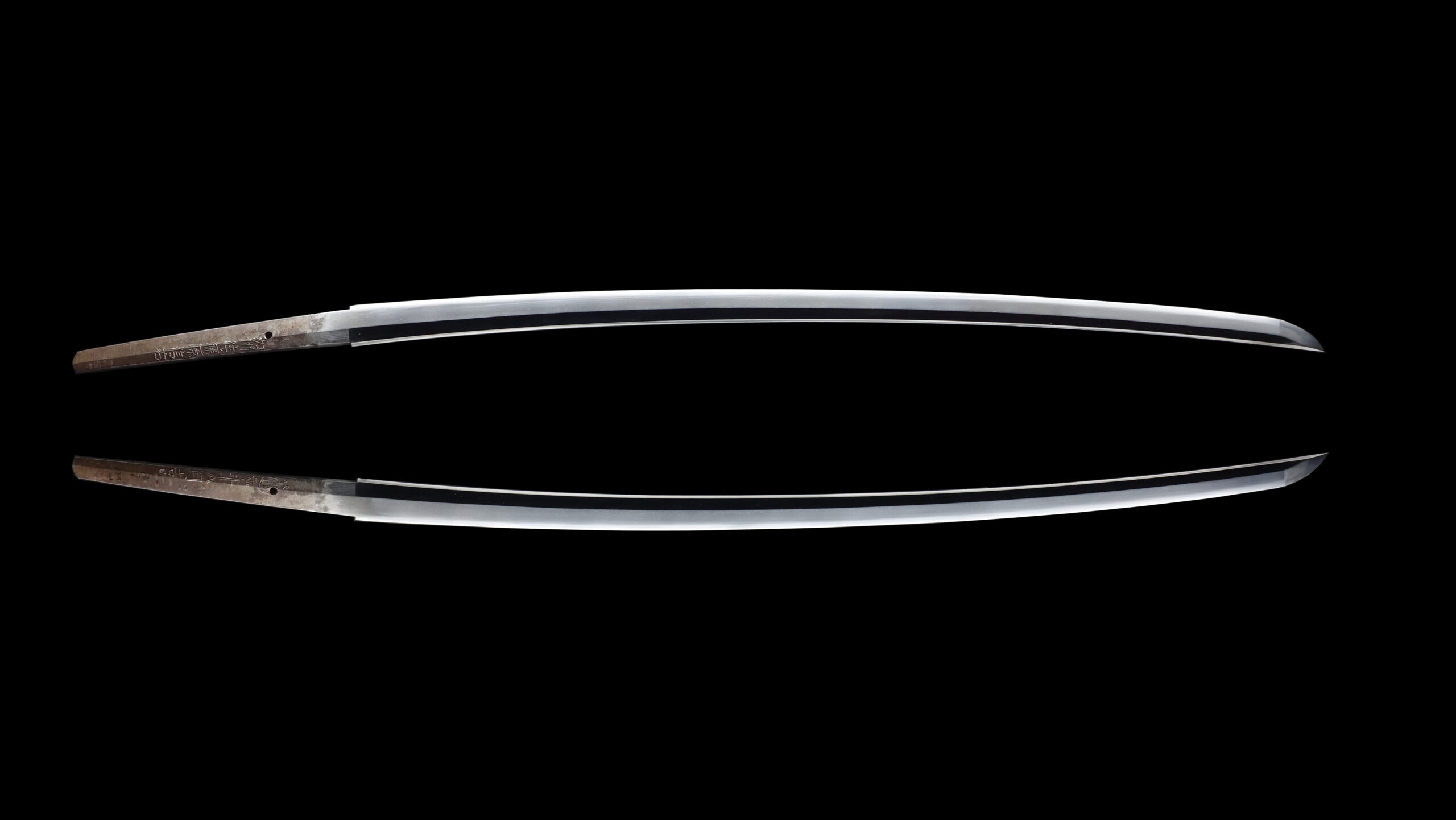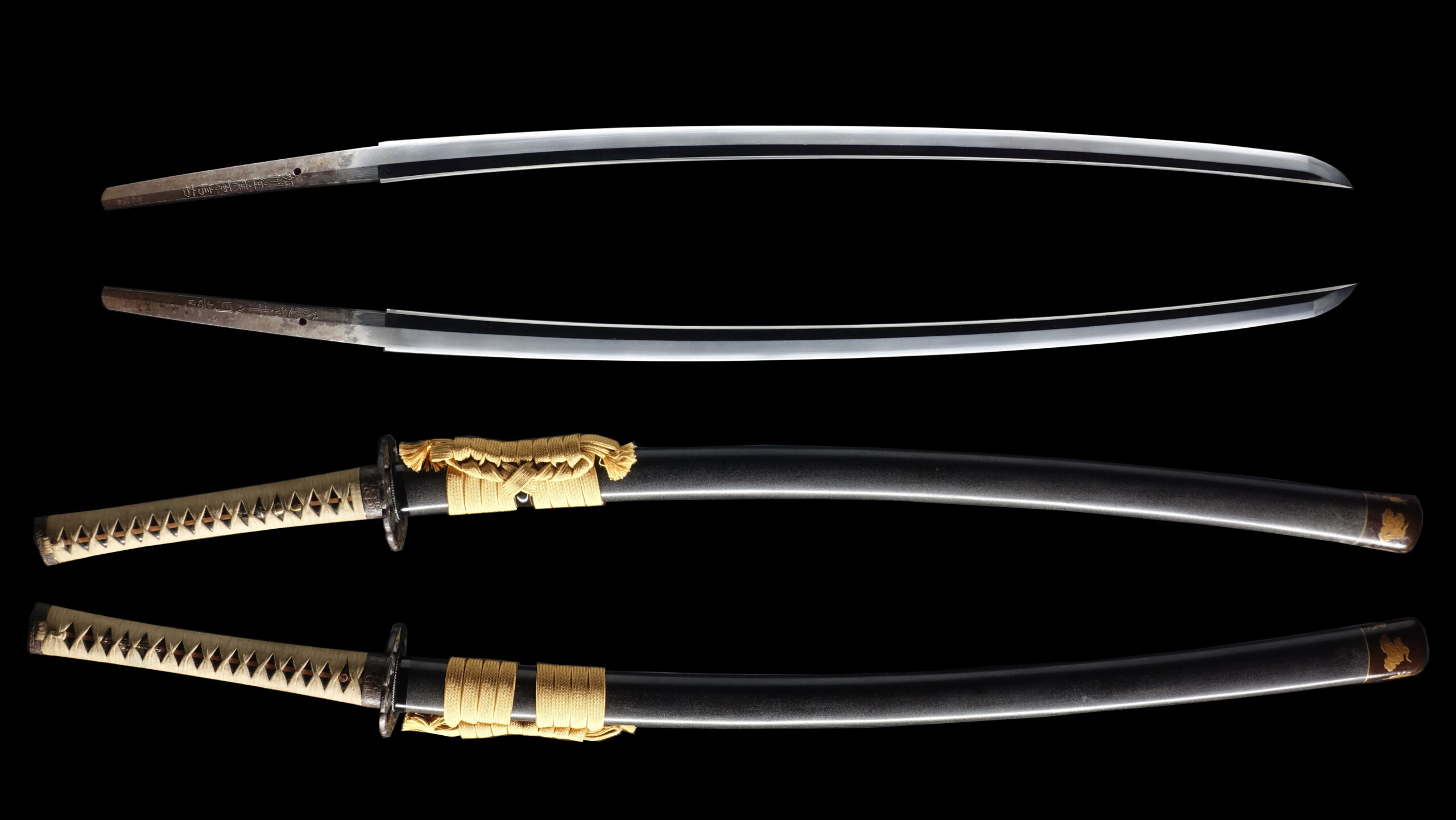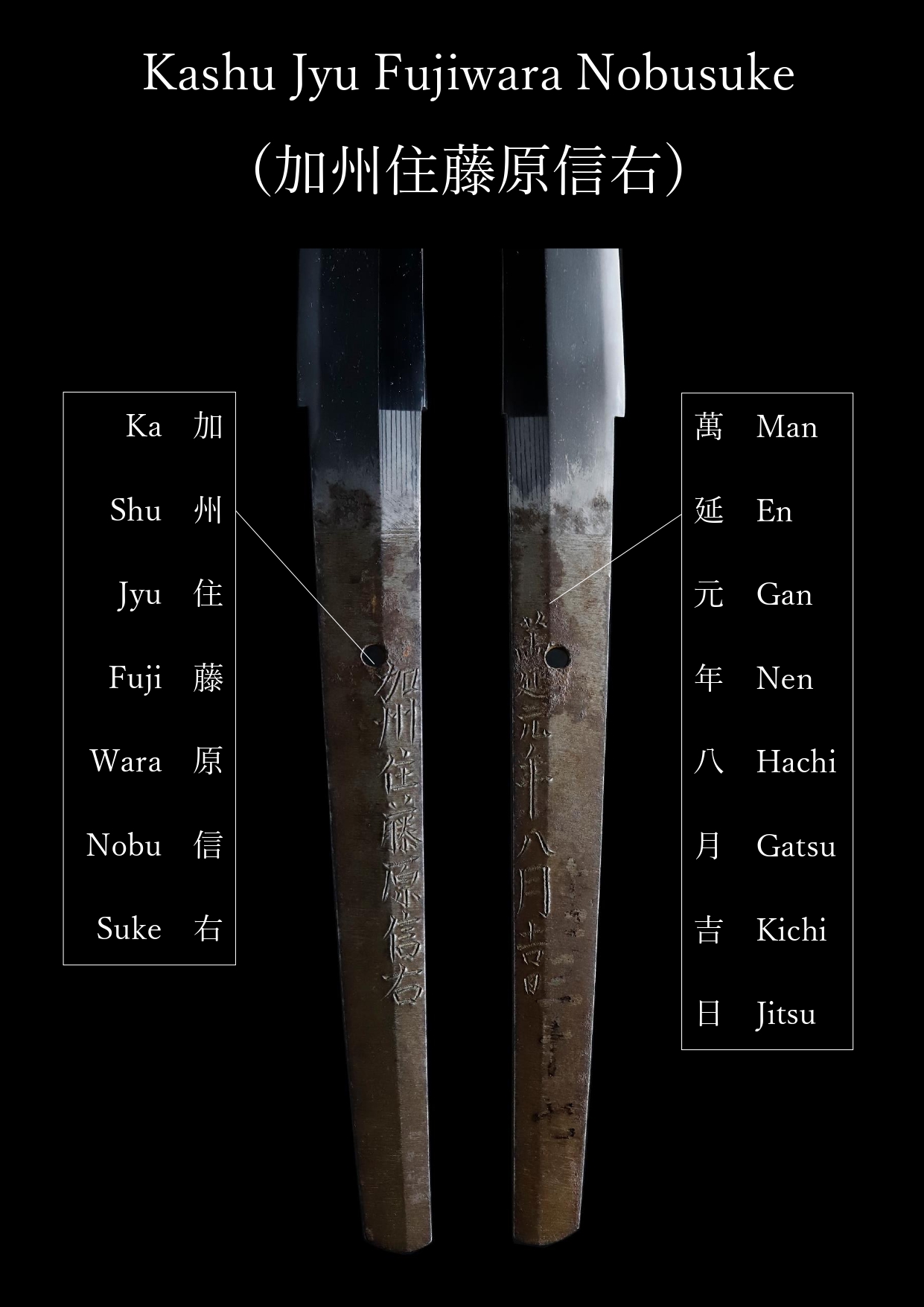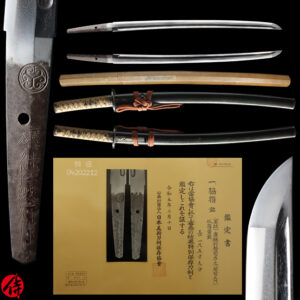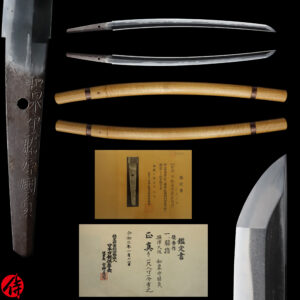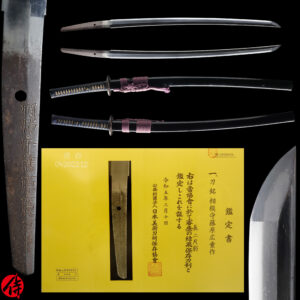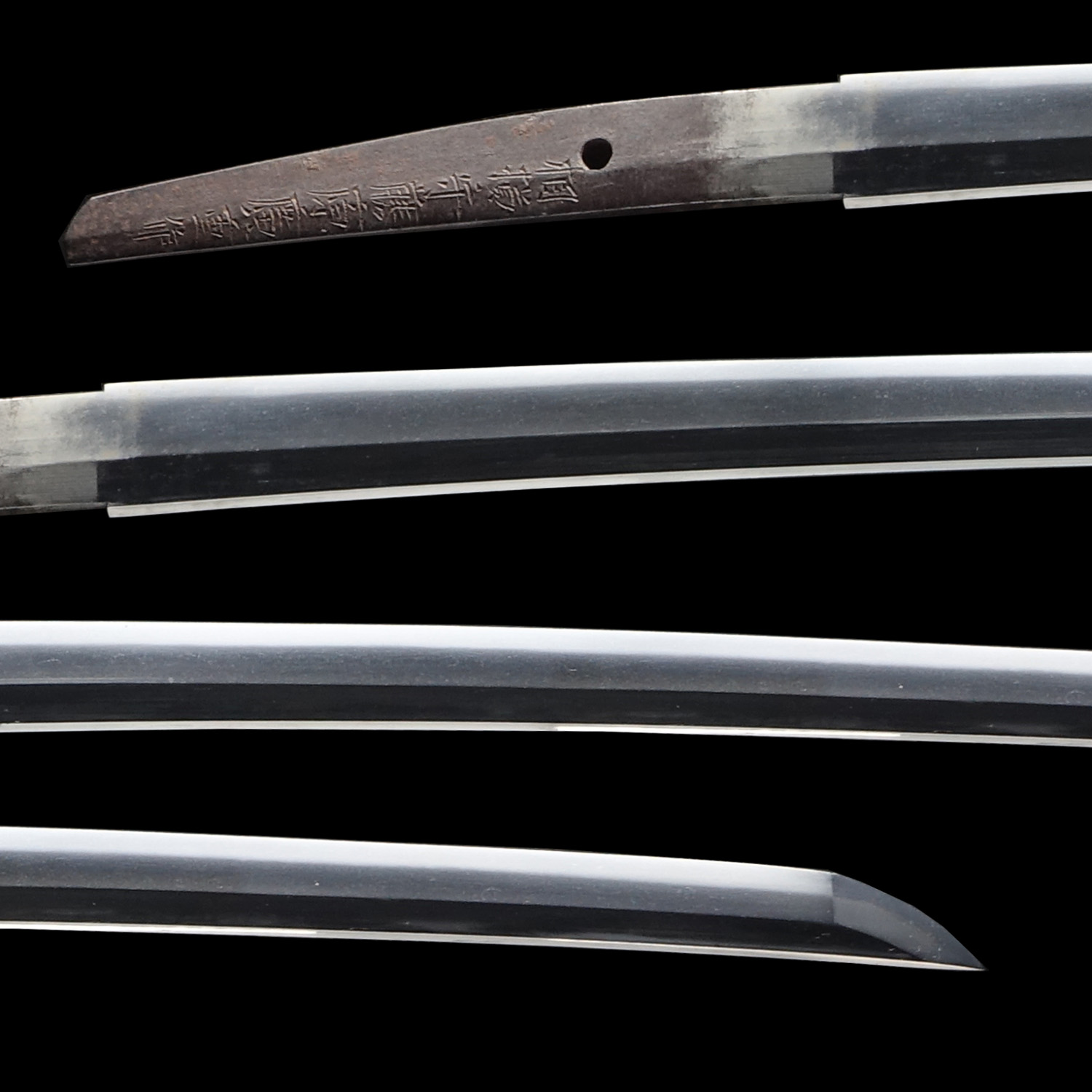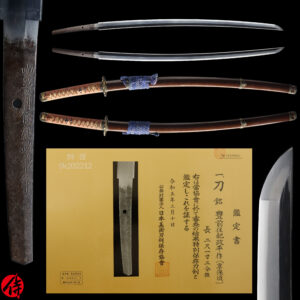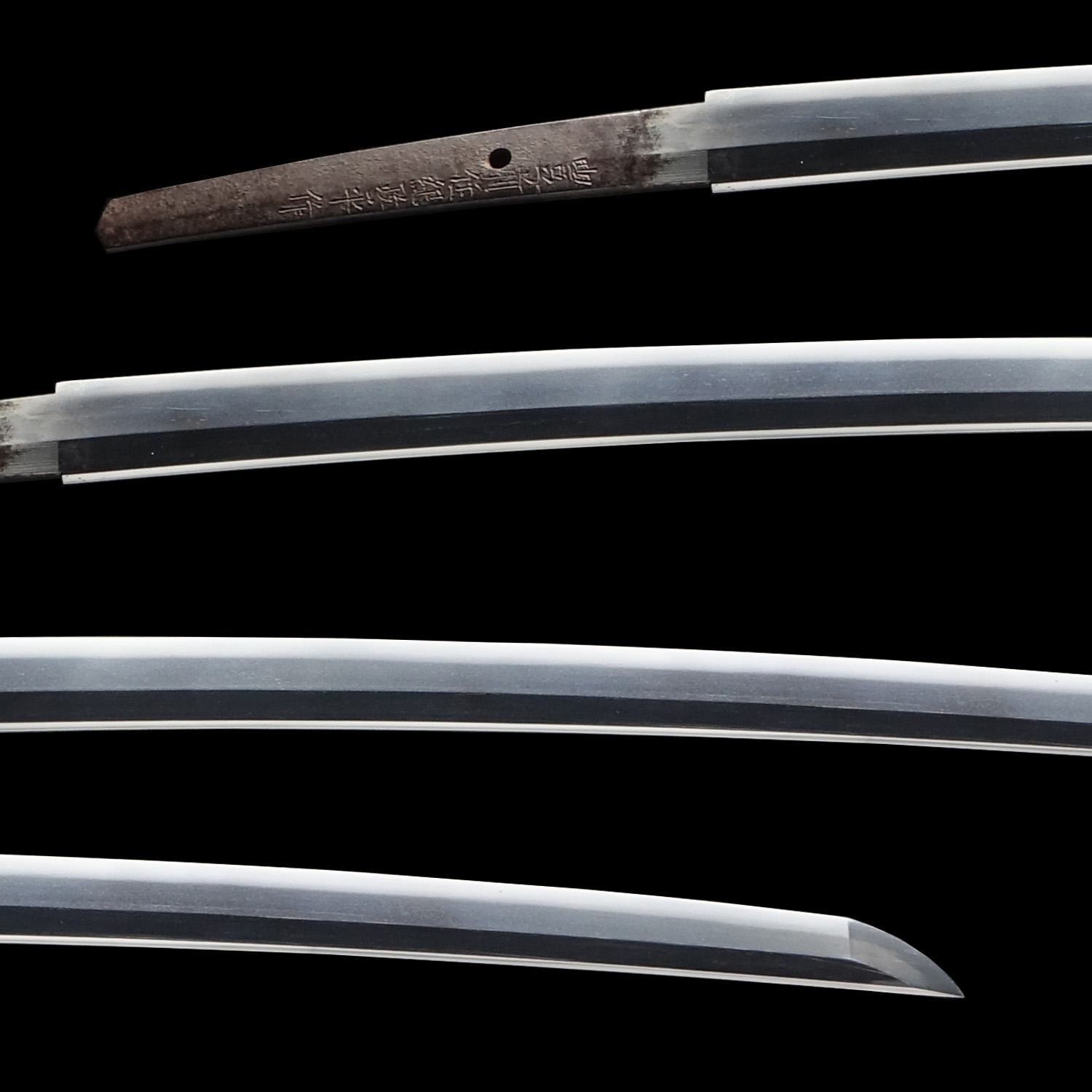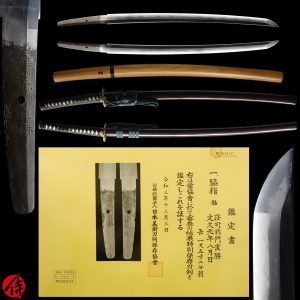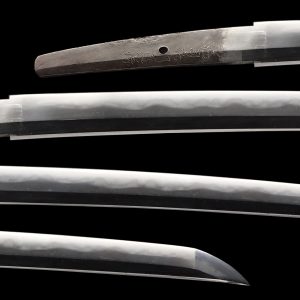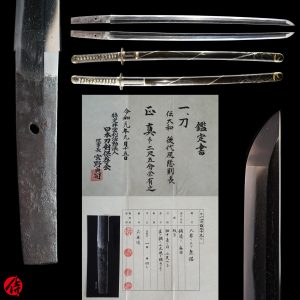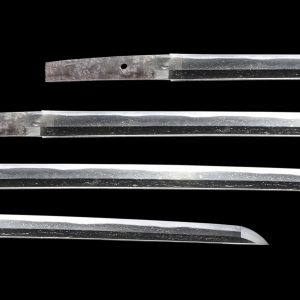Antique Japanese Sword Katana Signed by Nobusuke with Tokubetsu Hozon Certificate
【Description】
This blade was signed by Kashu Jyu Fujiwara Nobusuke (加州住藤原信右) in August, the first year of the Men-En era (1860: The end of the Edo period). Kashu Jyu means that he lived in Kashu province (today’s Ishikawa prefecture) when he forged this blade.
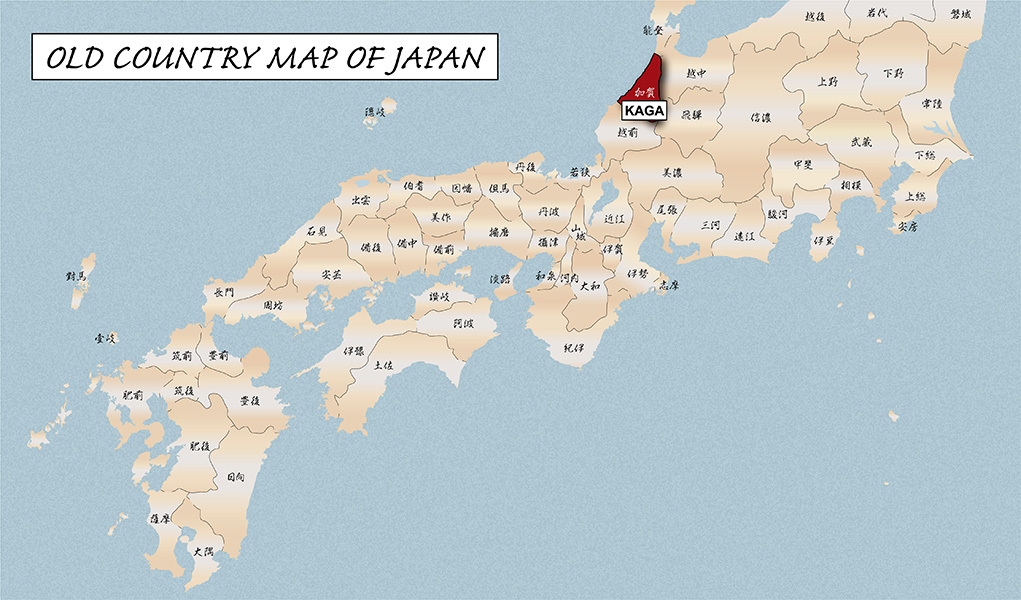
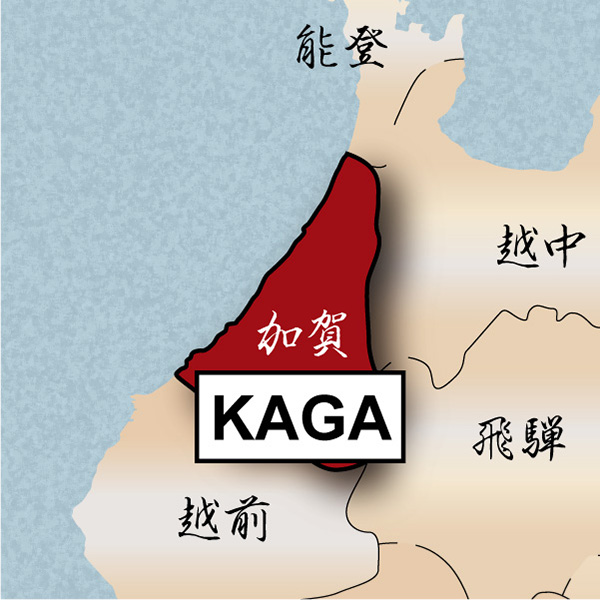
Japan enjoyed a relatively peaceful time from the early Edo period to the mid-Edo period(the 1600s-1760s) because of the stable economy and the powerful government run by Tokugawa Shogunate. Many Samurai didn’t have many opportunities to utilize his Katana sword in public or on battlefields during this time. Thus, they carried their swords more as a symbol of their social status. The demand for swords decreased accordingly compared to the previous Warring state period called Sengoku Jidai. (1467-1600)
However, toward the end of the Edo period(1764-1876), the Japanese sword’s role changed dramatically. With the poverty spreading in Japan, there were so many riots initiated by the civilians. Japanese sword started to play an essential role in maintaining public safety.
Pressure from foreign countries to open Japanese borders also forced Samurai to order strong-looking swords to survive this tumultuous time. We believe many swordsmiths including Nobusuke, made great efforts to forged high-quality, practical swords for their masters to prepare for battles.
There was a civil war between Tokugawa’s military government and the new Meiji government at the end of the Edo period. That means the original owner of this Katana might have seen the moment when Samurai’s life changed forever. This blade has a strong looking and must have been practical to use in that demanding time.
This blade was registered under the board of education in Ishikawa prefecture, where this blade had been forged. We presume the descendant of a Samurai had preserved it for generations since the end of the Edo period.
It is appraised as a Tokubetsu Hozon Token(特別保存刀剣) issued by NBTHK(Nihon Bijutsu Touken Hozon Kyokai:日本美術刀剣保存協会). This authentication paper was only given to authentic Japanese swords, especially well preserved and high quality with artistic value.
【 Blade】
Cutting Edge Length(Nagasa):69.4 cm (27.3 inches)
Curvature(Sori): 2.12 cm (0.83 inches)

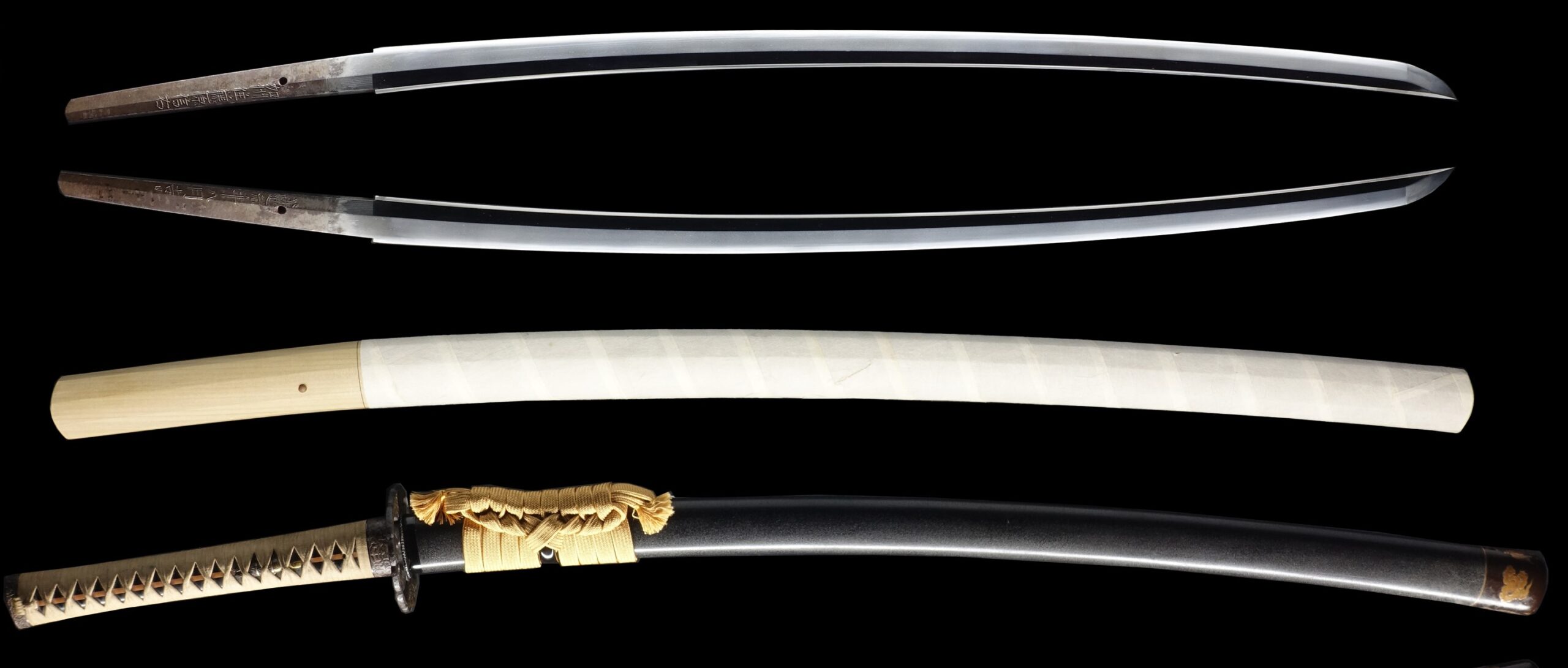
Hamon:
The crystalline structure which forms along the cutting edge of a blade as a result of the hardening process
Jimon(Jihada):
visible steel surface pattern created by folding and hammering during forging process
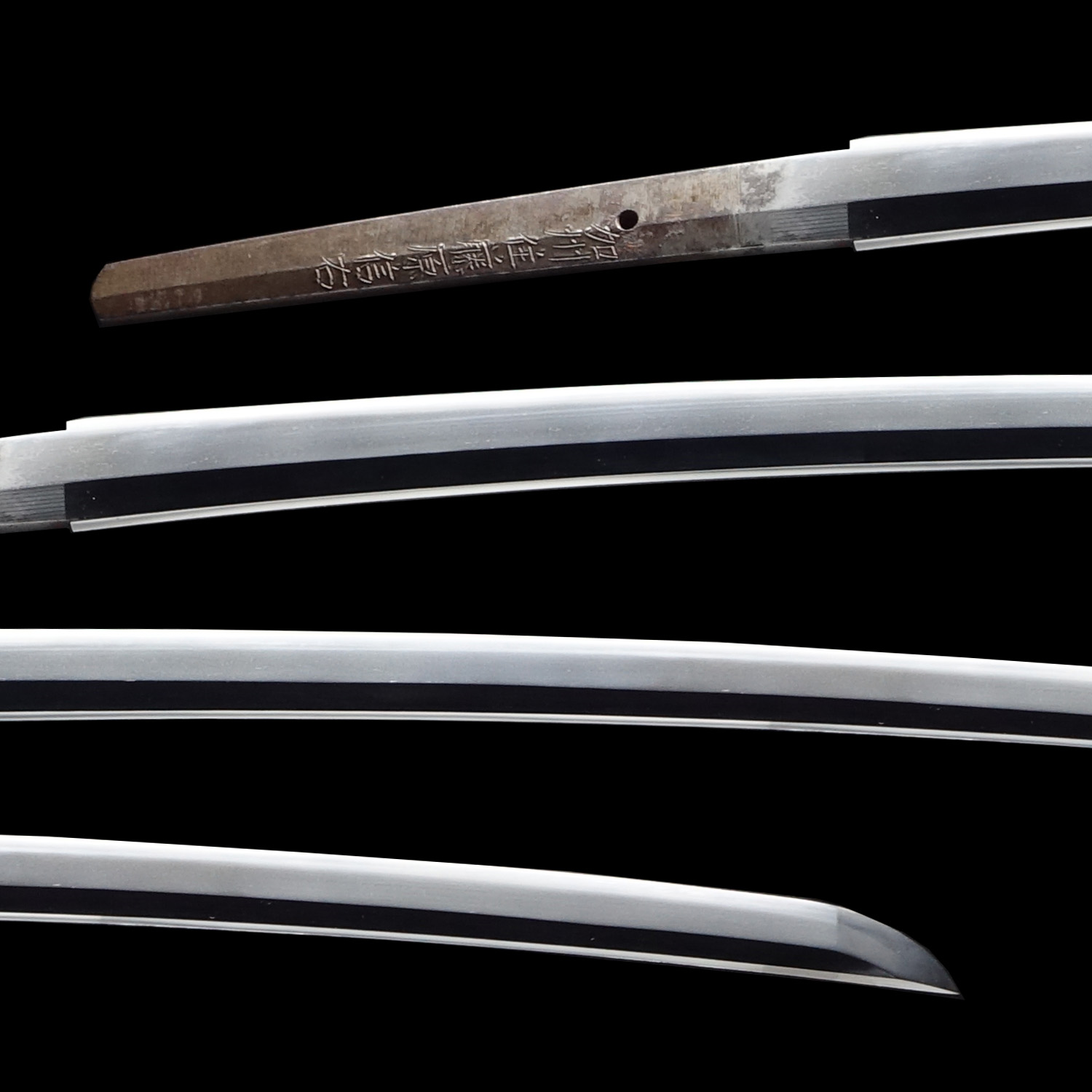
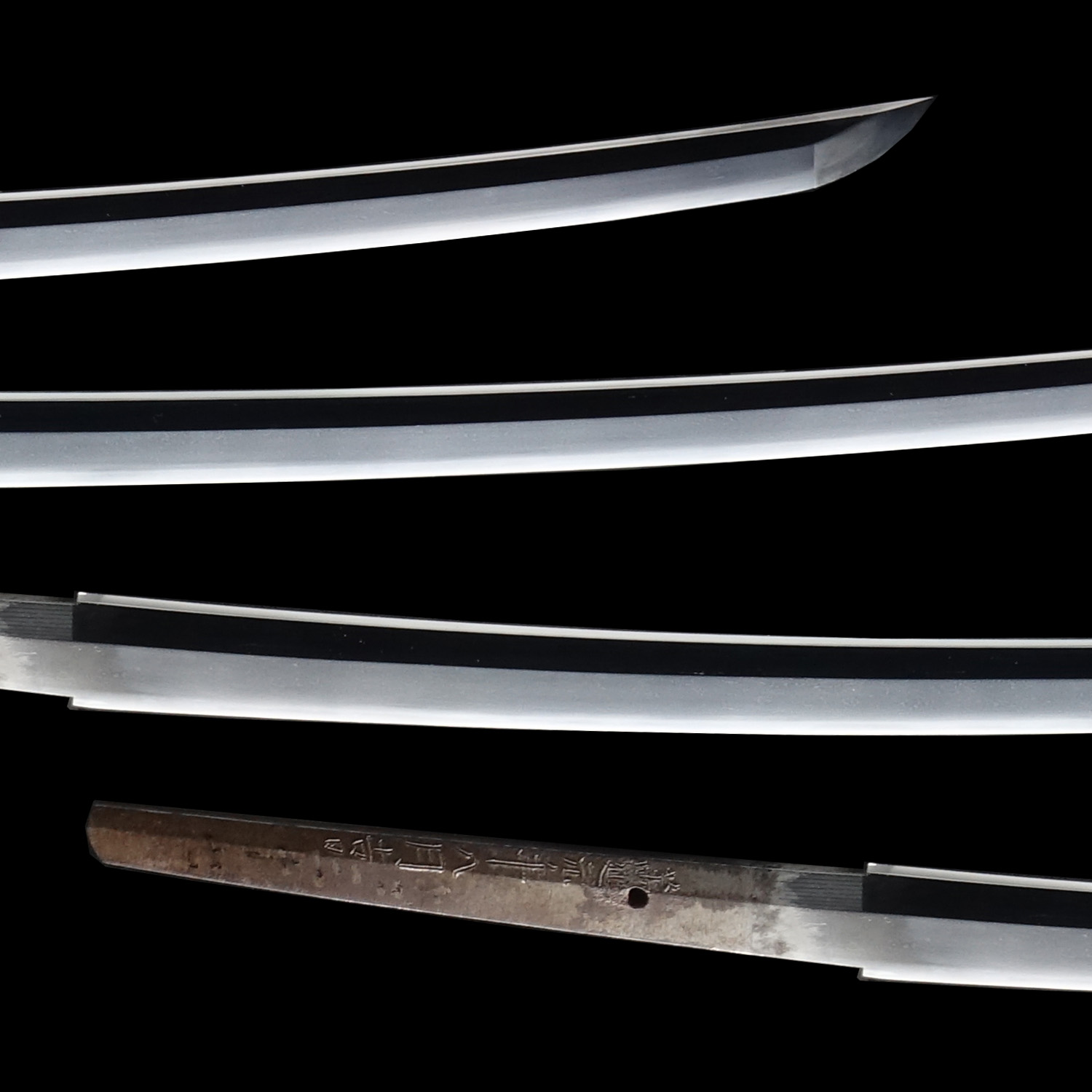
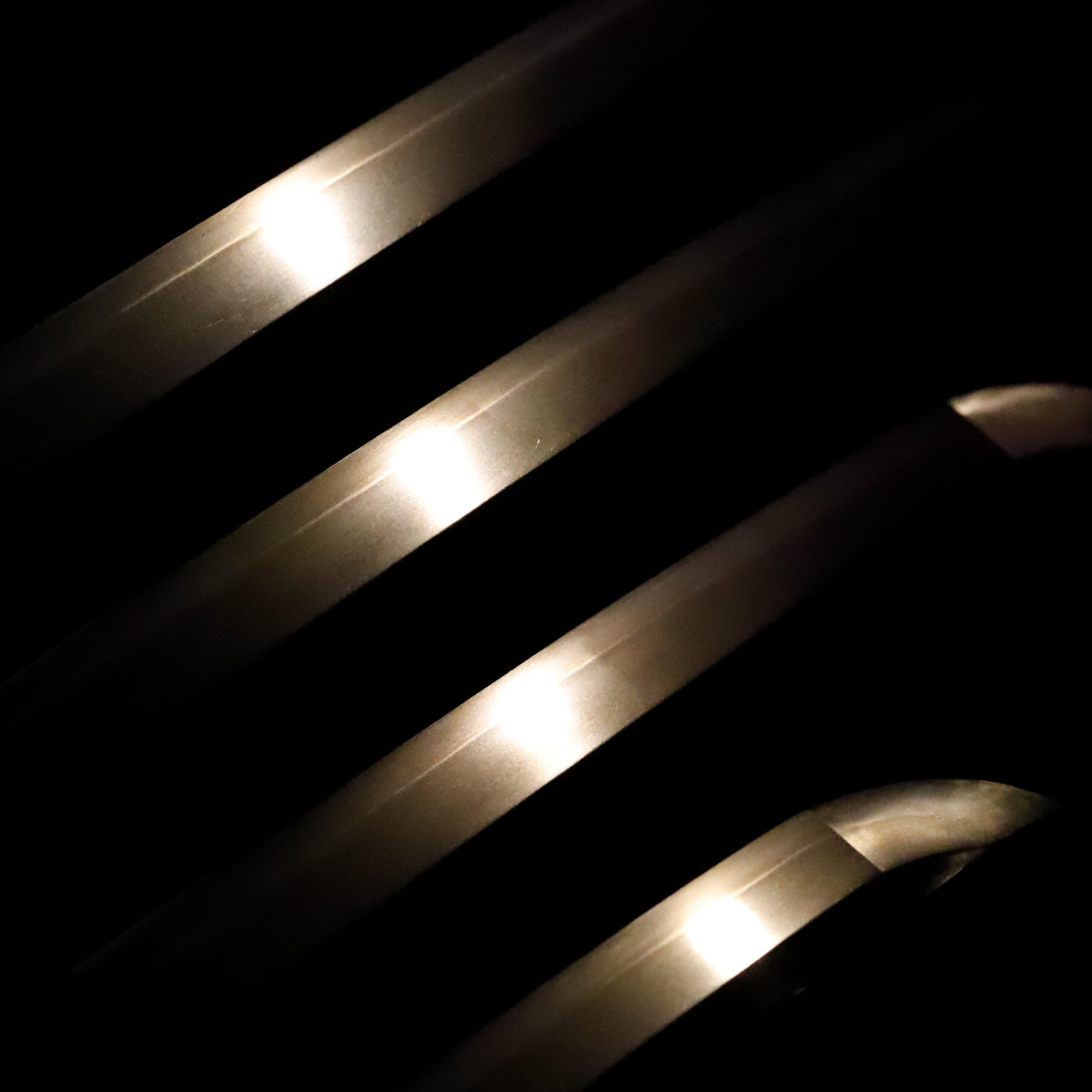
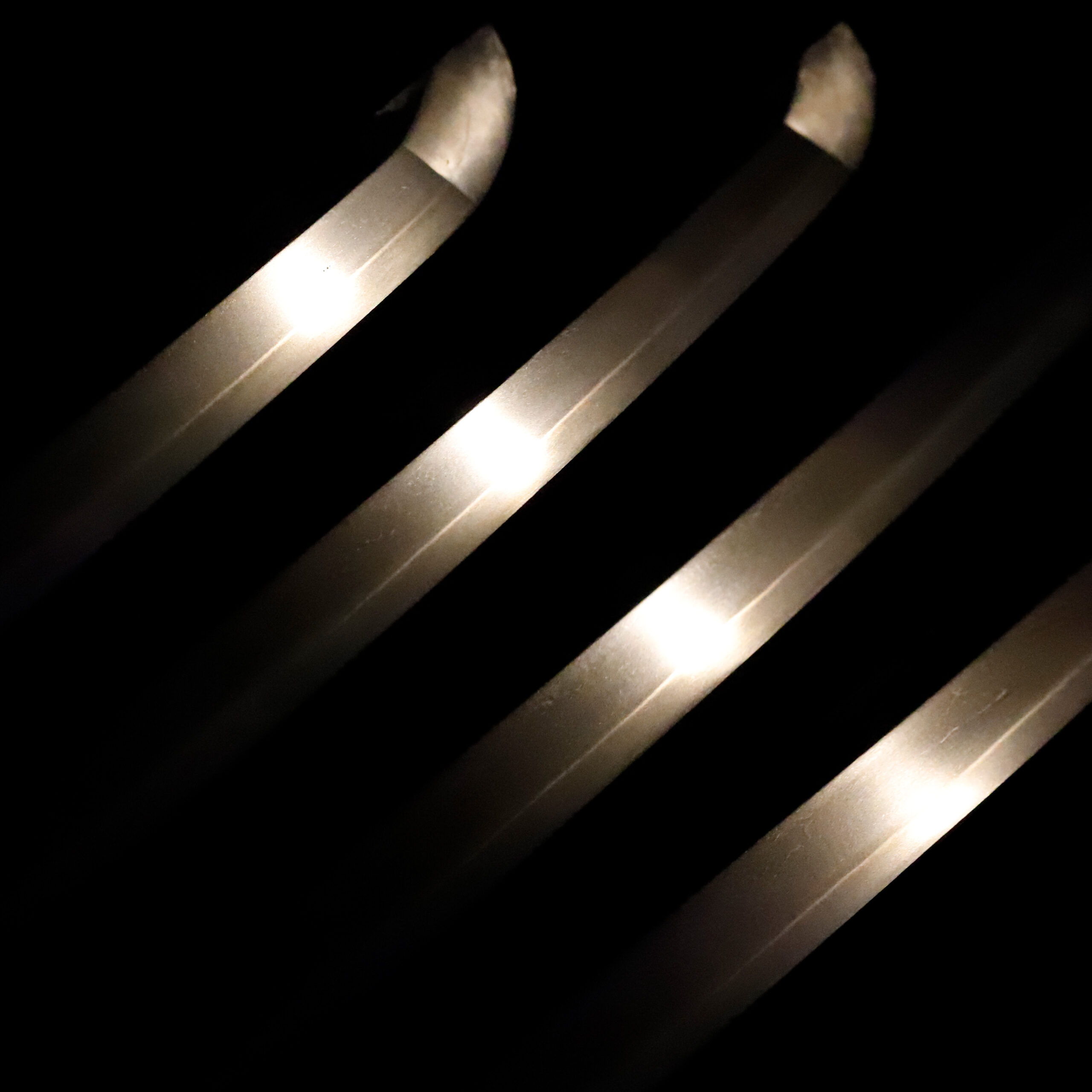
Nakago:Nakago is the tang of the Japanese sword.
Japanese swordsmiths left the black rust on the tang because it prevents red rust while the tang is in its handle. And the discoloration of the tang was created over time, and it is a great indicator for a Japanese sword specialist to estimate when the sword was forged.
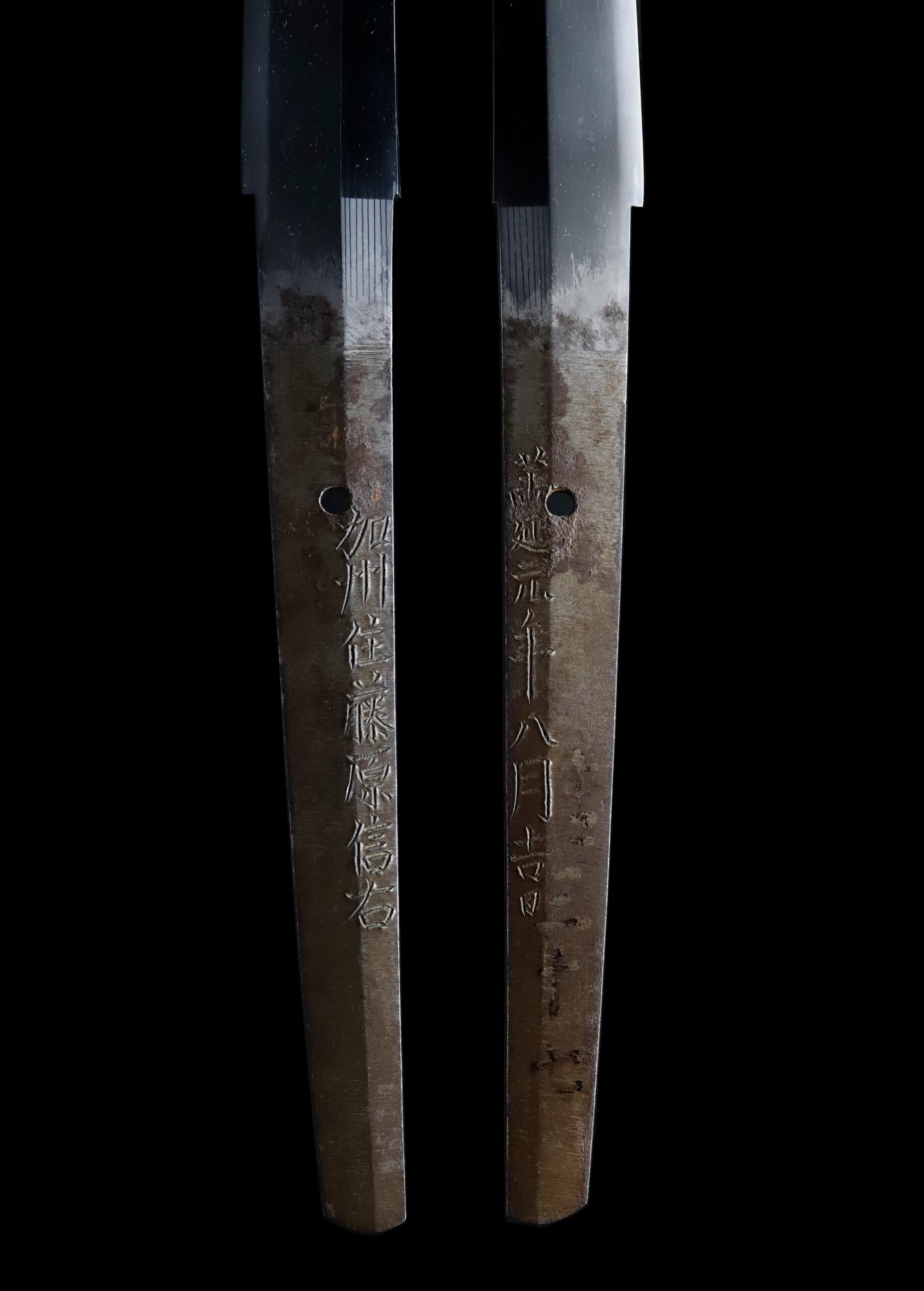
Koshirae: Koshirae is the mounting of the Japanese sword. There are several parts that consist of Koshirae such as Saya(Scabbard), Tsuka(Handle), Tsuba(Handguard).
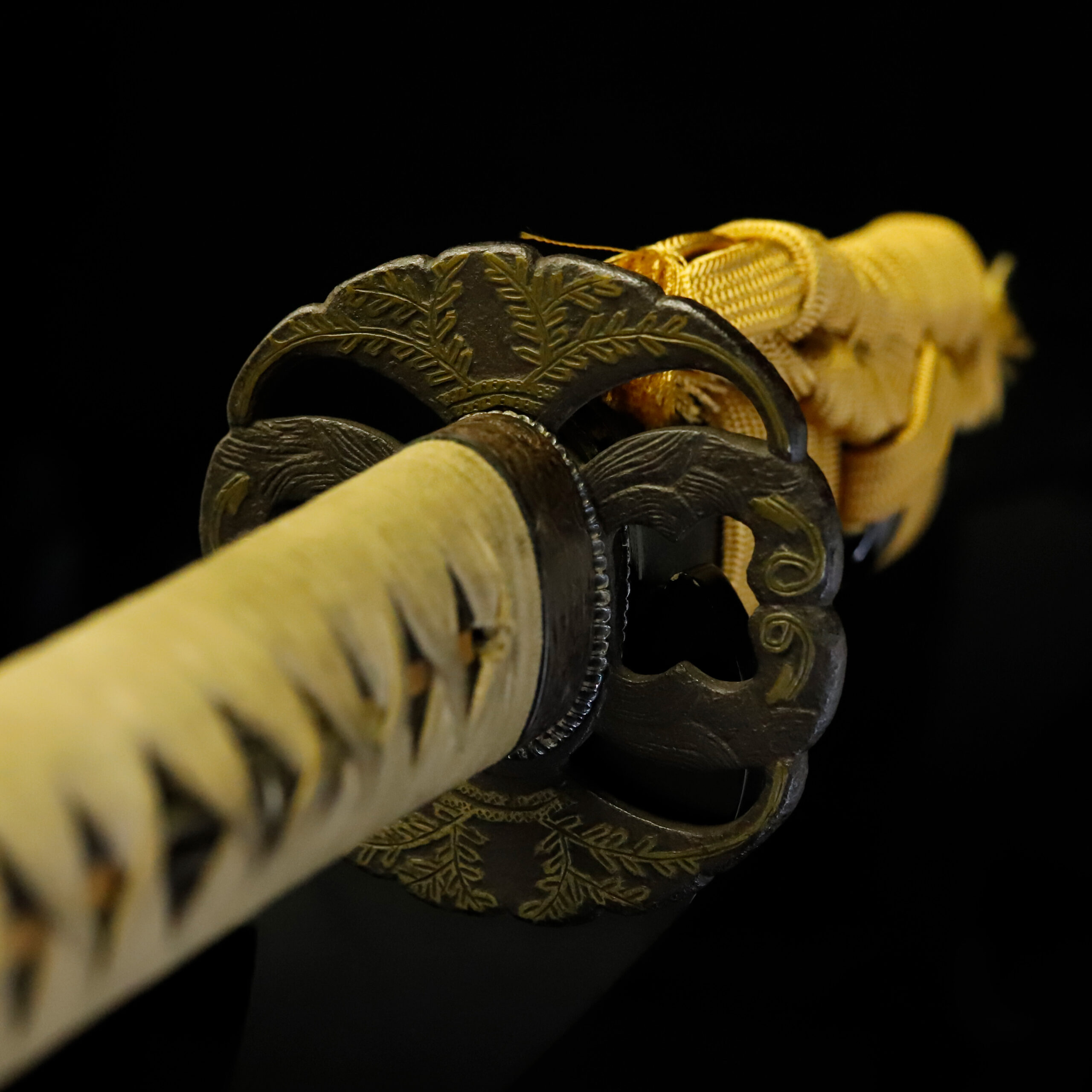
Fuchi-Kashira:A pair of matching sword fittings that cover the upper and bottom parts of its sword hilt.
The Karakusa (唐草, arabesque) pattern is principaly designed on this Fuchi Kashira. We could also find some letters are engraved; however, it is now challenging to read them due to their wear over time. The Karakusa design is a pattern in which vine stems, and leaves are twined and make curves. Since ivy has a strong vitality and grows up without interruption, people regarded this design as a symbol of prosperity and longevity. This plat pattern is often seen in sword mountings and adds decorativeness to works.
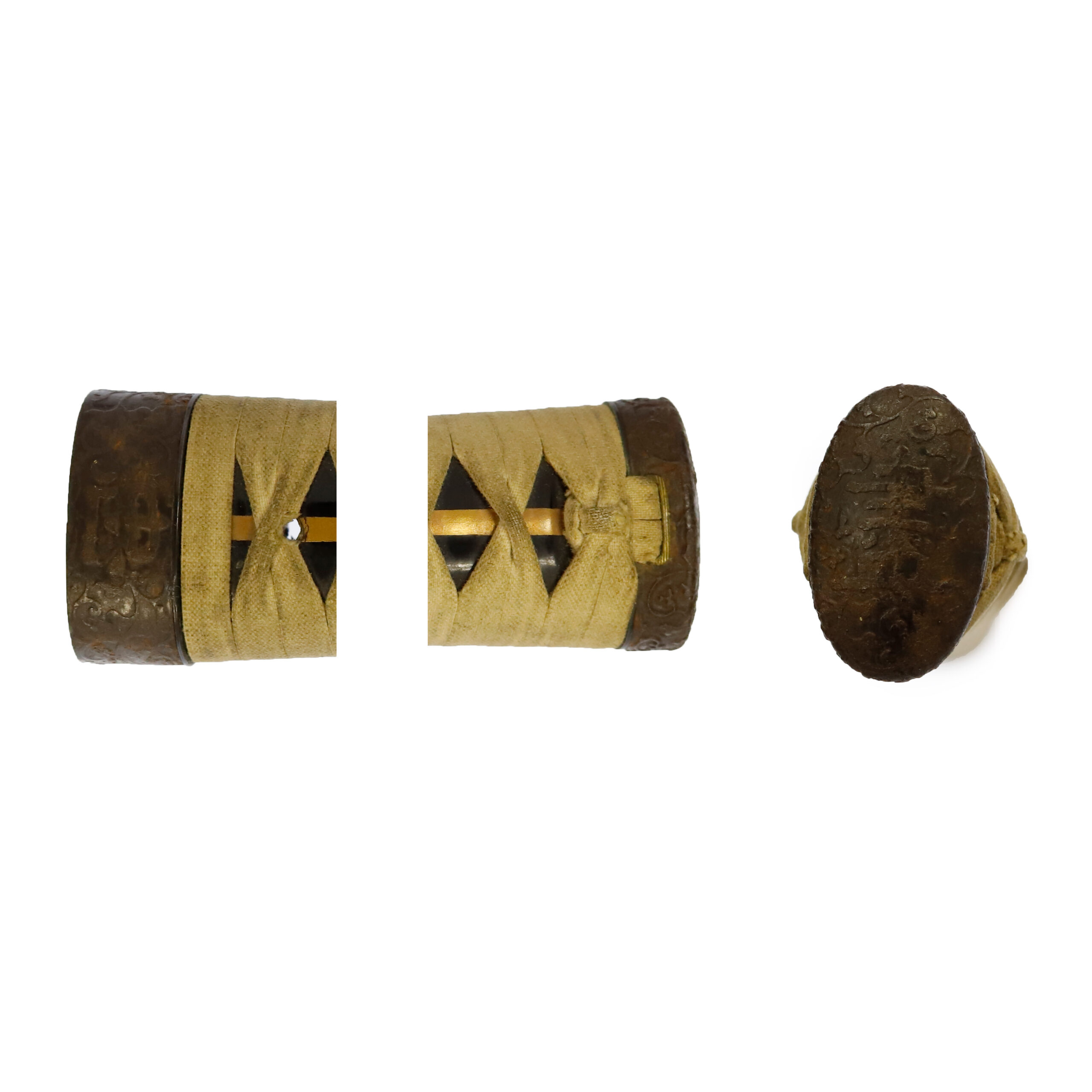
Tsuka and Menuki:Tsuka is the handle of the Japanese sword and Menuki is its decoration.
Musical instruments are the motifs of this Menuki. The upper side Menuki, we think a Shou (笙), one of the wind instruments of Gagaku (雅楽, ceremonial music and dances of the Imperial Court of Japan), is designed. It is made by bundling 17 bamboo tubes of various lengths. A shape in which the longest bamboo is placed on both sides and combined so as to be depressed toward the center.
On the other hand, the lower side Menuki motif is a flute. Since there are many kinds of flutes in Japanese musical instruments, judging which flute is specifically here is challenging.
Musical instruments such as drums, Koto (琴, a zither-like Japanese musical instrument), and flutes have beautiful tones and resound loudly. People believed that it was a good way to communicate with gods, and they recorded these instruments as parables of things “getting better.” It is said that is why musical instrument patterns are often used in Noh (能, the oldest surviving form of Japanese theater) costumes.
In addition, the musical instruments that play the tunes of the beautiful dynasty culture are said to be the education of aristocrats and are patterned in various ways in hopes of improving their skills. Moreover, since Japanese musical instruments make a loud sound, there is a view that says it is a good luck pattern for a plentiful harvest in the sense that it bears wonderful fruits. It is an idea of wordplay using the common sounds of the two expressions, “音が鳴る (Oto-ga Naru, the tone sounds)” and “実がなる (Mi-ga Naru, fruit grows.” Thinking not only about the beauty of the design itself, but also the meaning and wishes people put into it would make the appreciation even more enjoyable.
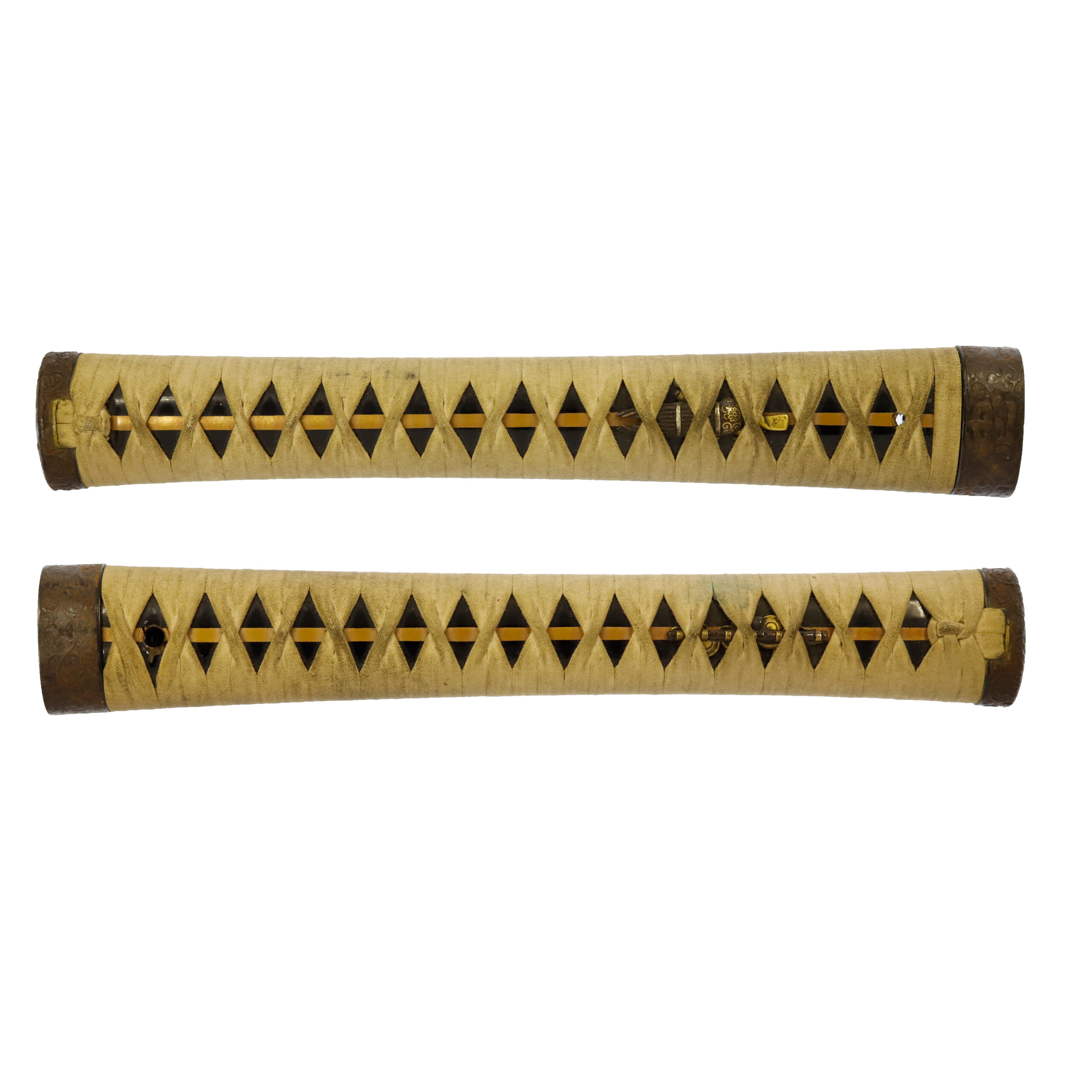
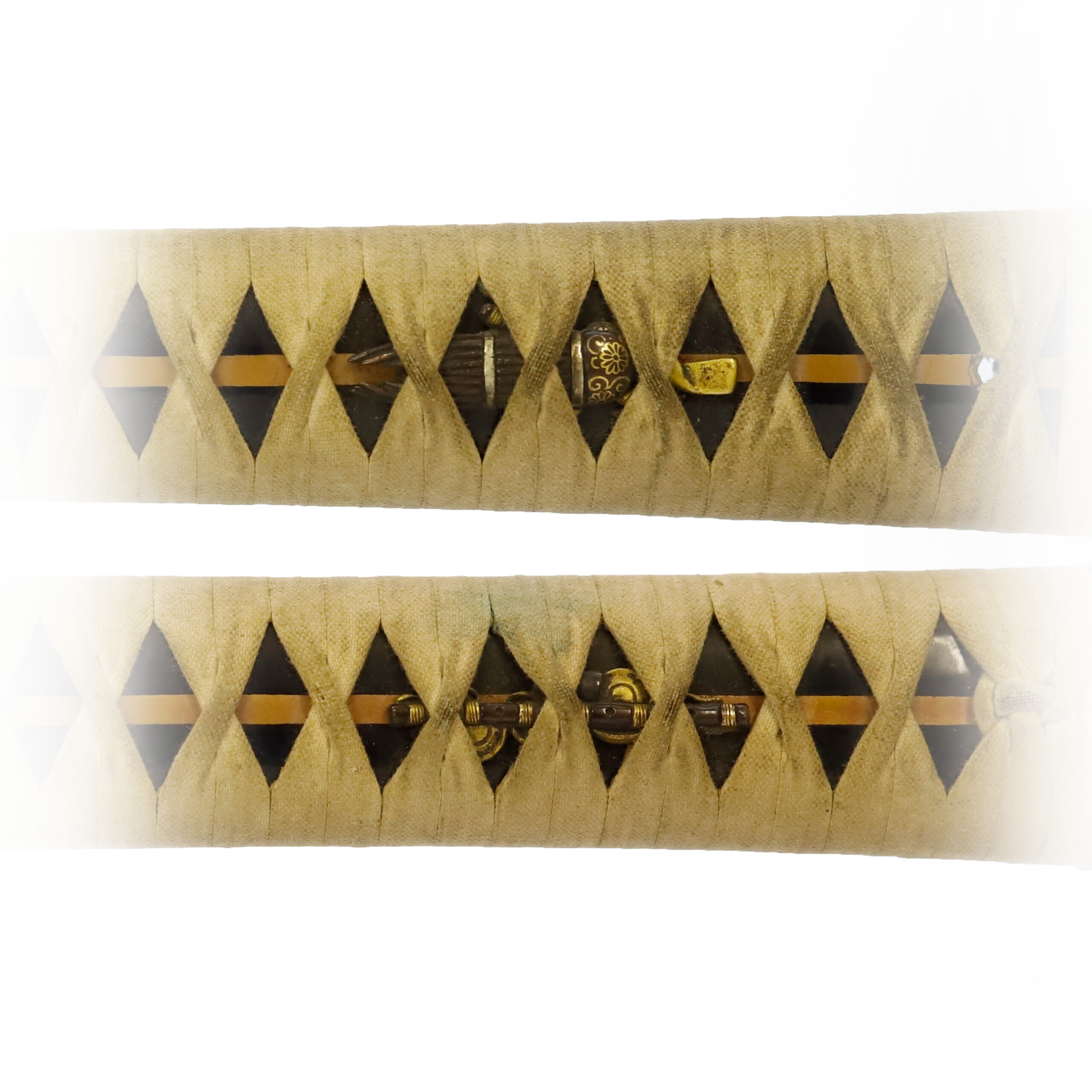
Tsuba and Habaki:Tsuba is the handguard for the Japanese Sword and Habaki is the equipment to make the blade not touch its scabbard inside. It prevents the blade from getting rusty and chipped.
This Tsuba has a symettrical design; the top and bottom are in the shape of Ichou (銀杏, ginkgo) leaves with a Shida (羊歯, fern)-like plant pattern, and the left and right sides are probably designed with the Myoga (茗荷, Myoga ginger). As ferns have a high fertility rate, Shida patterns represent children’s prosperity and success in business. Also, “羊歯” can be written as “歯朶” in Japanese. “歯” means ages, and “朶” means branches grow long; therefore, it symbolizes longevity. In Japan, people treat this plant as a good-luck omen, so it has been used for decorations of entrance in the New Year.
Myoga is known as Japanese ginger and was brought to Japan with Shoga (生姜, ginger) from the continent. According to a theory, Shoga was used to be called “Senoka,” and Myoga was used to be called “Menoka” in ancient times. It is said that these pronunciations were changed with time. Myoga has the same pronunciation as another word, “Myoga (冥加),” which means divine protection. Therefore, this motif has been treated as a good-luck design. It is seen at shrines and temples in various parts of Japan.
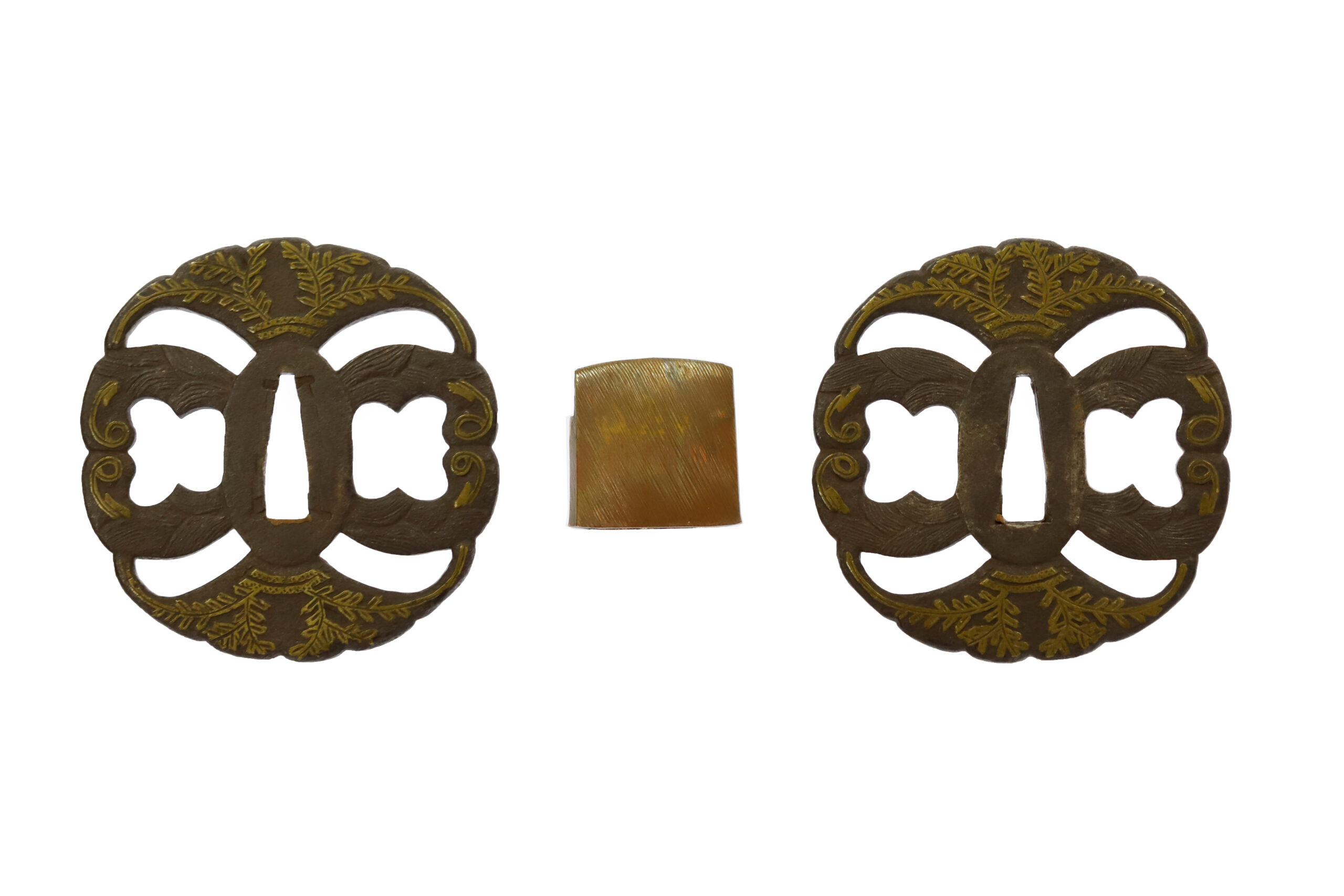
Saya: Saya is the scabbard for the Japanese sword.
If you focus on the end of this scabbard, you will find that the Kojiri (鐺, the metal fitting that protects the tip of a scabbard) has a decorative look. Clouds are designed on it. Clouds bring rain and snow, and their movements significantly affect the day’s weather. Due to its supernatural power, a theory says that gods, spirits, and dragons dwell in the clouds. Cloud patterns have been associated with magical power, and people thought it an omen of lucky things. In addition, as clouds appear repeatedly, their designs represent reincarnation. Samurai warriors were always on the verge of life and death on battlefields. They might have believed in the power of this pattern.
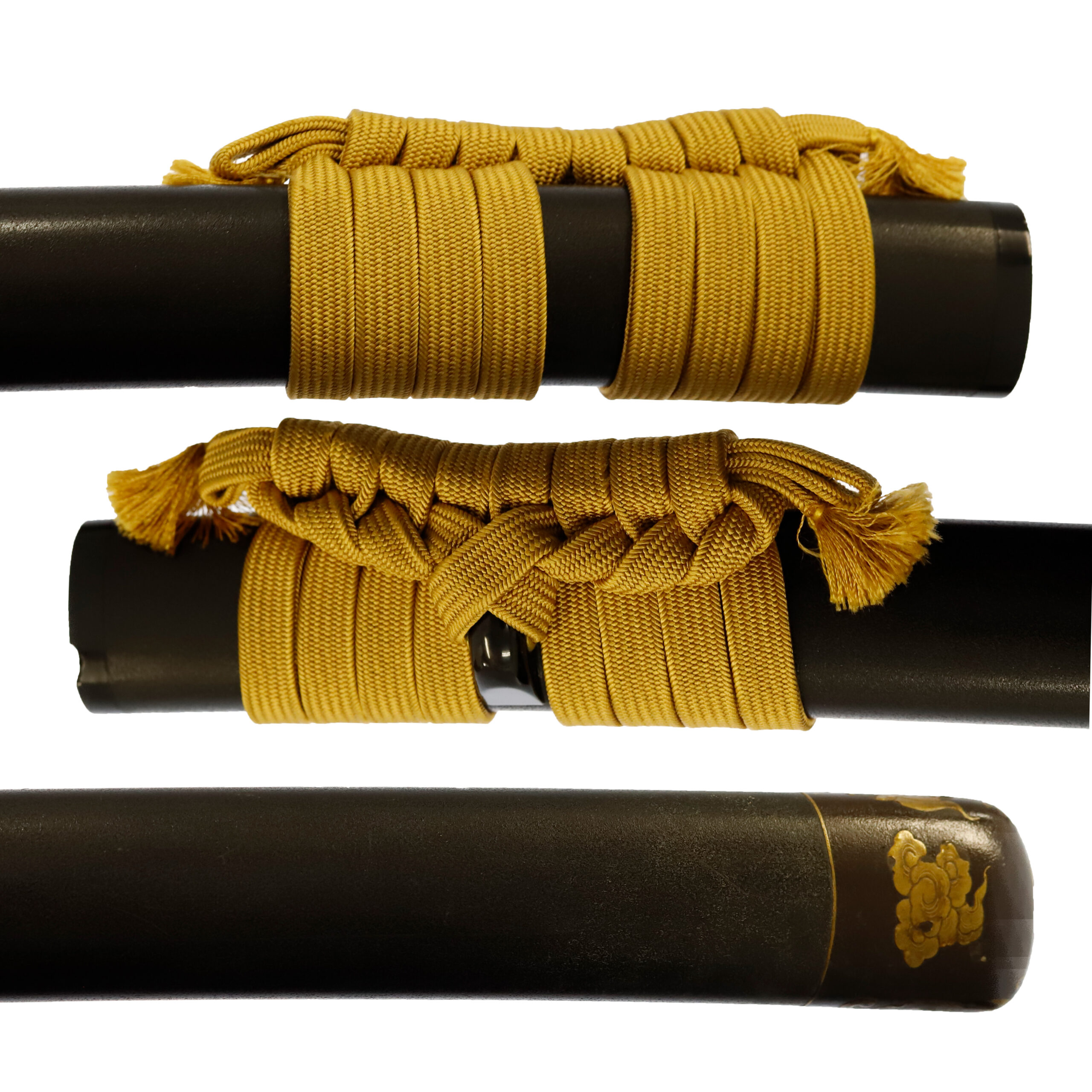
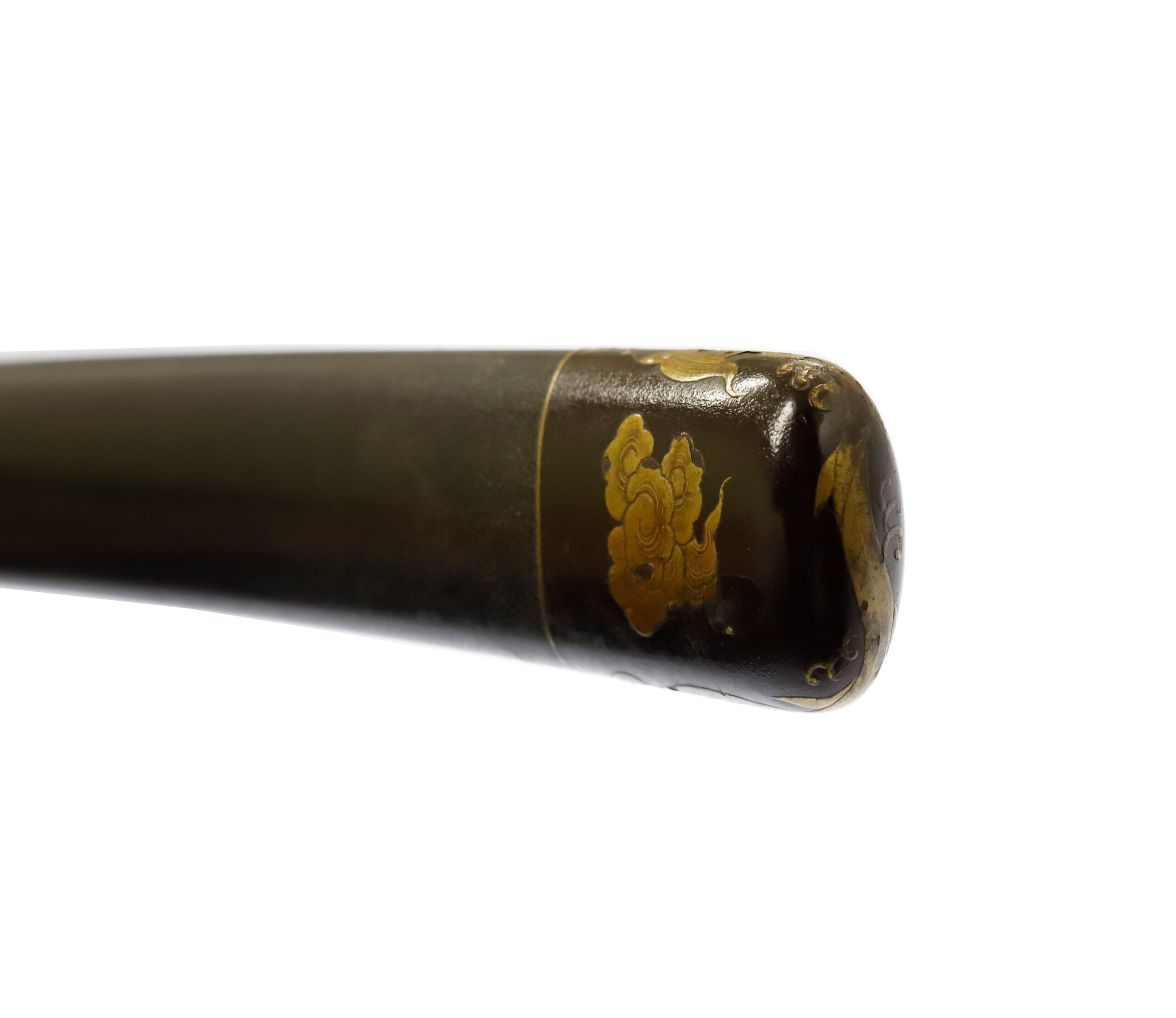
Authentication Paper:NBTHK TOKUBETSU Hozon Certificate for the blade (No. 1017815)
NBTHK, also known as Nihon Bijutsu Touken Hozon Kyokai (the Society for the Preservation of the Japan Art Sword), is one of the oldest Japanese sword appraising organizations in modern-day Japan. They authenticated the blade on June 3rd in the 4th year of Reiwa (2022). They appraised it as Tokubetsu Hozon Touken, the blade especially worth preserving for Japanese society. The purchaser will receive this original certificate as well. We can also translate what is written into English and make a PDF file for your record if you request.
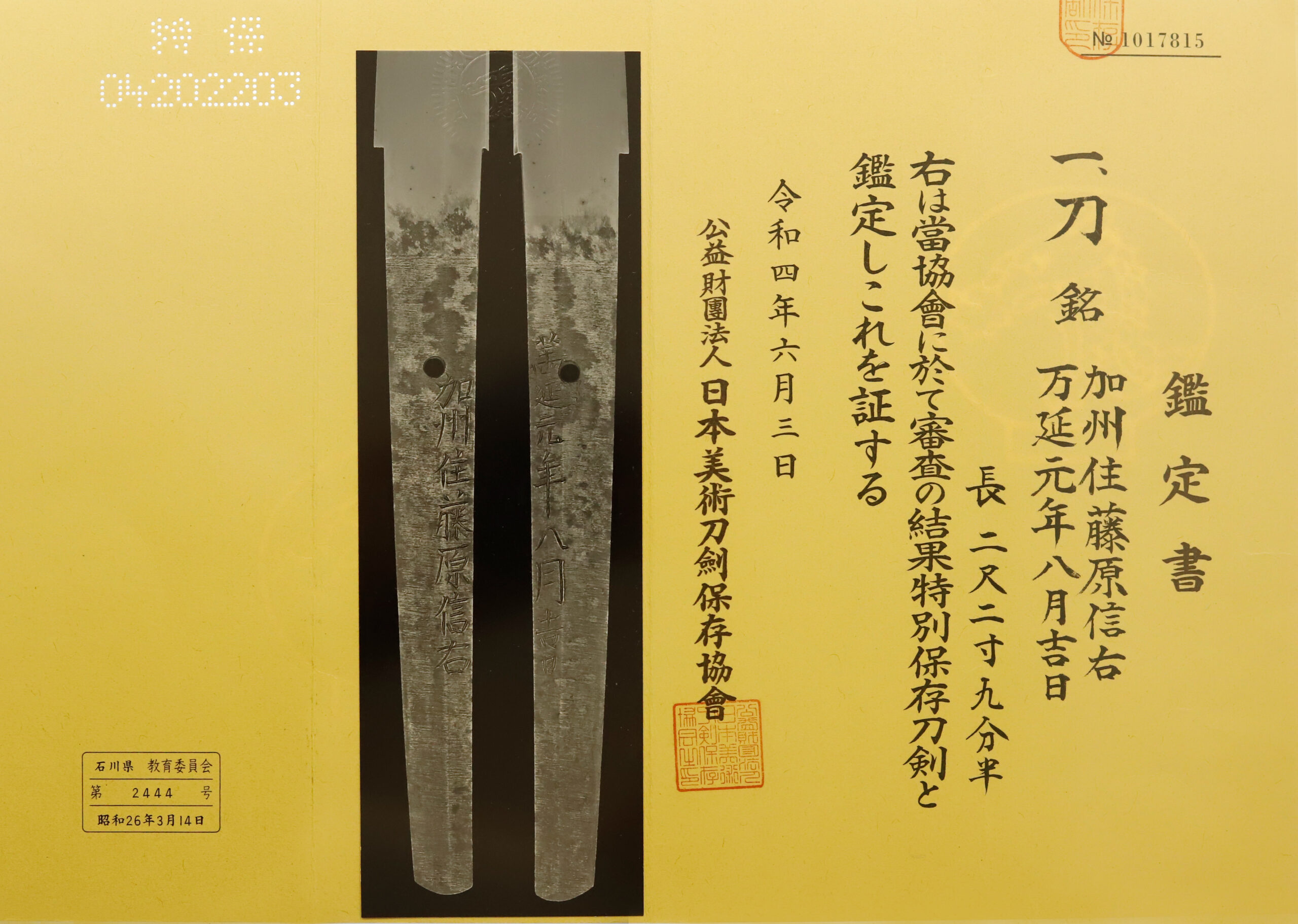
Registration Number : Ishikawa 2444
The Board of Education in Ishikawa prefecture issued a registration paper for this sword . It is called Jyu Token Rui Torokusho(銃刀剣類登録証). Bunkacho(The Agency for Cultural Affairs) acknowledges a Japanese sword with this paper as a work of art.
The sword needs to be traditionally hand-forged and made of Tamahagane carbon steel to be registered in the system. With this paper, its owner in Japan can legally own an authentic Japanese sword. Based on this registration number, we will apply for its export permit.
This paper will need to be returned to the board of education when the sword is being shipped abroad, but you can receive a copy of it. An English translation of this registration paper is available on request.
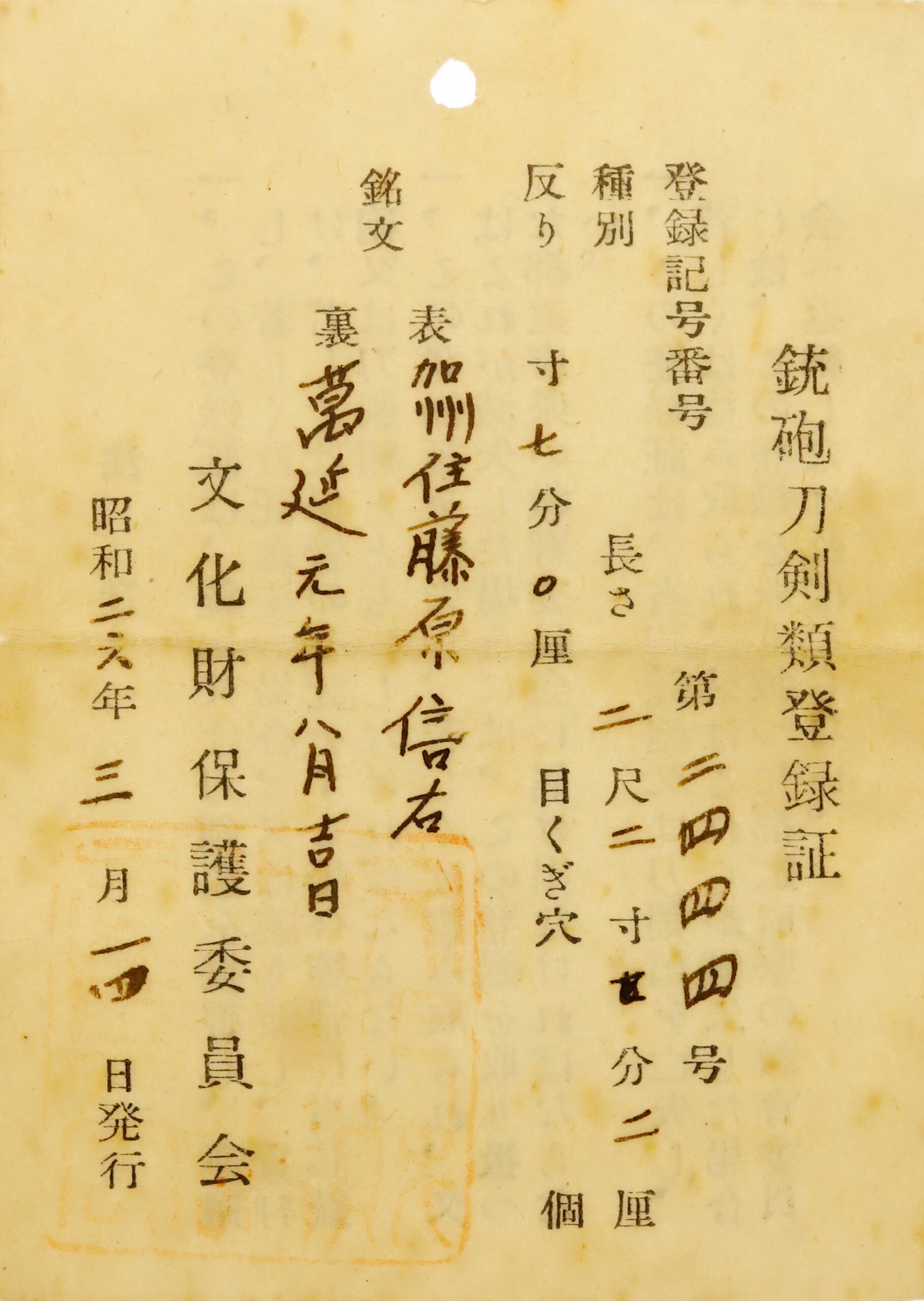
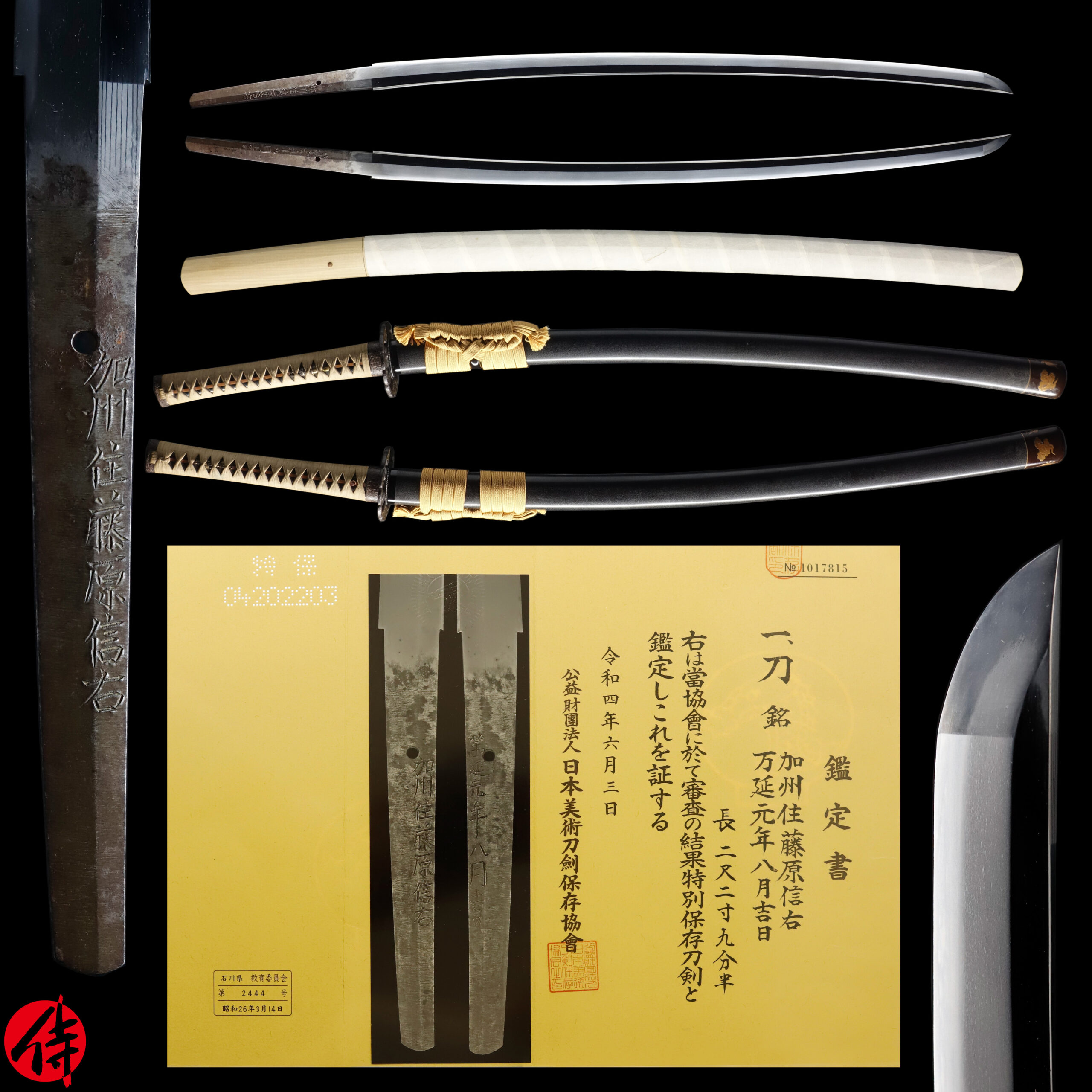
—————————————————————–
【About us】
Samurai Museum is located in Tokyo, Japan, exhibiting antique artifacts related to the Samurai history. Samurai Museum Shop is the place for those who are interested in Japanese culture and craftsmanship. We deal with antique Samurai swords/armor, traditional crafts made in Japan and so on.
【Japanese Sword& Export Process】
The Japanese swords we deal with are hand-forged edged swords made in Japan. It was made from the traditional carbon steel called TAMAHAGANE(玉鋼). Samurai Museum is familiar with the proper legal procedure for an antique/ authentic Japanese sword to be exported from Japan. We have sent more than 500 Japanese swords for the past three years (~2023) to amazing owners who appreciate its historical value.
Each Japanese sword is registered under the Agency for Cultural Affairs and the Board of Education in Japan. They issue a registration paper for each Japanese sword for its owner in Japan to legally possess it. The Japanese sword with its registration paper means it was traditionally hand-forged in Japan.
To legally export the sword from Japan to other countries, we will have to apply for its permit to the Agency for Cultural Affairs(Bunkacho) and return the original registration paper to the Board of Education. It normally takes around 2-4 weeks to receive this permit after submitting required documents. And we would like you to expect at least 1-1.5 months for your order to arrive at your given address after you ordered. For more detailed info, please click here.
It is allowed for residents in Japan to own authentic Japanese swords without a special license as long as they come with registration papers. Please feel free to contact us if you are a resident of Japan, whether temporarily or permanently. We will also assist you when you leave Japan and need to obtain an export permit. If you live in Japan, please click here before you make a purchase.
【Payment Method】
We accept payment through Stripe (Credit card), PayPal, Apple Pay or ChromePay, all of which are secure payment methods. Also, you don’t need to make an account on Stripe for the checkout. If you prefer other payment method, please contact us. After confirming your payment, we will apply for an export permit. You may either pay in JPY, USD, AUD, CAD,EUR CHF or GBP. The price is set in Japanese Yen. Prices in other currencies are automatically calculated based on the latest exchange rate.

* If the amount is above 1 million JPY, Stripe or wire transfer will be the only options for payment.
【Shipping】
We have shipped authentic Japanese swords to the USA, UK, Canada, Mexico, Germany, France, Hong Kong and Australia. If you don’t live in these countries and like to order, please contact us first before making a purchase. We offer Free International Shipping as long as we can send antique Japanese swords by EMS.
We normally ship by EMS(Express Mail Service) provided by Japan Post. We will send you a tracking number for your order as soon as we hand it to the post office. We will put 100 % insurance on the shipping document without any extra charge. Based on the total amount, there might be a duty tax or other fee for you to pay, depending on the countries. We use package cushioning to protect the item and put it in a PVC pipe, which is one of the most secure packages because of its durability.
It will normally takes 5-14 days for the item to arrive at your given address after we dispatch it. Time of delivery is estimated as accurately as possible by the carrier but does not take into account any delays beyond our control such as by inclement weather, post office holiday seasons.
* If you live in Australia and like to purchase an authentic Japanese sword, please click here to know the detail.
*Please keep in mind that due to the spread of COVID-19, there might be delays in shipping. If you like to know the detail about shipping, please feel free to ask us.

【Review】
Here is one of the reviews we received from a customer who purchased an authentic Japanese sword from us. For more reviews, please click here.
“My experience overall with the whole process was wonderful. I had many questions about the history and process to purchase these treasures. All my questions were answered very timely and complete. The staff is very knowledgeable and very well versed if any questions do arise.”
【How to make sure the condition】
Please keep in mind that what you are going to purchase is an antique item. We uploaded high resolution photos for you to check its condition thoroughly. If you like to see more photos with different angles, please feel free to contact us. We will be happy to send them to you so that you can make informed decision. It is essential for us to know that you are happy with your choice of a sword. and we are prepared to use the best of our ability to serve you.
【How To Contact Us】
Please contact us through email, Facebook Messenger or Live Chat if you have any questions. You can find each icon on the right side of the website. Please click one of them to reach us. We will reply to you within 1-2 business days.
【The Art of Nihonto (Japanese Sword)】
Samurai’s history is a profound, eloquent legacy of ancient Japanese warriors in which millions of people worldwide are being fascinated. If you like to find out the art of Nihonto, please click here.
【A Guide to Japanese Sword Maintenance】
After acquiring an genuine Japanese sword, it is also important to know how to take good care of it. Here is the special video for you. Mr. Paul Martin, Japanese sword expert, shows you how to give proper maintenance to your sword. By mastering how to clean the Japanese sword, its aesthetic beauty will last forever.
When you purchase a Japanese sword from us, you can get a Free Japanese sword maintenance kit. It comes with four tools(Choji Oil, Uchiko Whetstone Powder, Peg remover, Oil Applicator). By watching the video instruction above , you can enjoy learning how to maintain your Japanese sword while appreciating it. If you have any difficulty assembling the sword or cleaning the blade, you can feel free to contact us.


MORE ANTIQUE JAPANESE SWORD FOR SALE
SWORDS WITHOUT CERTIFICATES FOR SALE
LEARN JAPANESE SWORD TERMINOLOGY
Thank you for reading all the information on the page. If you have any difficulty choosing the right Japanese sword for you, we will be more than happy to help you find the one that speaks to you the most. Please feel free to contact us.
